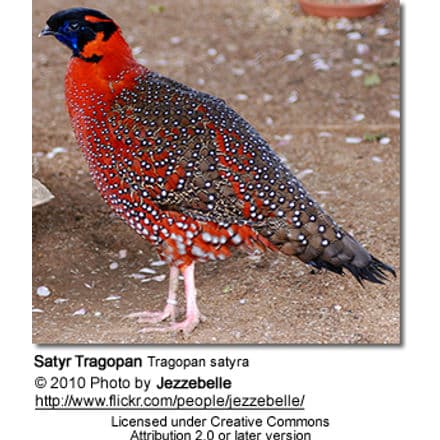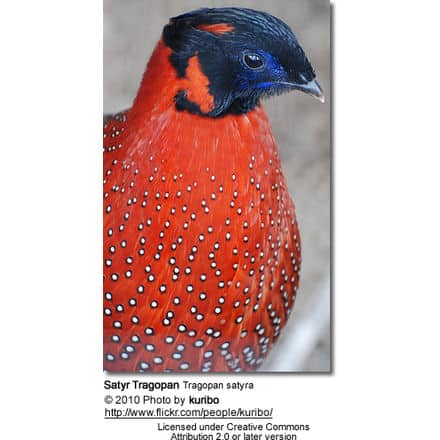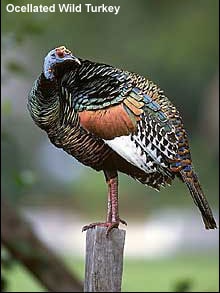Satyr Tragopans (Tragopan satyra) also known as the Crimson Horned Pheasants
Keeping and Breeding the Satyr Tragopan
Courtesy of Alan Downie and Zoë A. Hunter
The Satyr Tragopan (Tragopan satyra) are also commonly referred to as the Crimson Horned Pheasant. Tragopans are commonly called “horned pheasants” because of two brightly-colored, fleshy horns on their heads that they can erect during courtship displays.
The Satyr Tragopan is endemic to the Himalayan reaches of India, Nepal and Bhutan. They reside in forests from with an elevation ranging from 8,000 to 14,000feet in summer and 6,000 feet in winter.
Other Releated Web Links: Pheasant General Information … Pheasant Species … Pheasant Taxonomy … Breeding Pheasants … Pheasant Photo Gallery … Housing Pheasants … Pheasant Diseases … Peacock Information … Peafowl Species List
Description
The tragopans are very unusual birds with inflatable lappets and horns. The Satyr Tragopans is quite heavy, the cock is around 4lbs in weight.
He has a dark brown back with a mostly black head and black on the end of his tail. However he also has a glorious deep red breast, the red stretches right up over the neck and the base of his wings and covers his belly.
To add to this his body is covered with lots of white ocelli edged in black. There are some red feathers on the crown and a glimpse of bright blue can be seen on or around the face. It is here the tremendous transformation takes place.
Size: Male 68-72 cm; female 58 cm. Weight: Male 1.60-2.10 kg; Female 1.0-1.20 kg.


Breeding the Satyr Tragopan Pheasant
As the breeding season approaches the blue will be seen more and more. Often the cock will give his head a shake and the bib will “fall”.
His display is certainly worth watching. He will nod his head and you will probably hear a strange noise like a balloon or tyre being pumped up. His head nodding will become faster and more like a bow over and over until he rushes up to the hen and pulls himself up to his full height with his wings outstretched and the lappet and horns completely extended he stands quivering slightly until very suddenly the show is over and everything returns to normal.
The lappets are blue with red/pink blotches and extend to about 4 inches long.
The hens of the tragopans are very similar and great care should be taken not to mix them up. The Satyr hen will start to lay usually at the beginning of April.
She can lay about 12 eggs in the season ( around 4 eggs in a clutch). Unlike many pheasants she will often lay in an elevated nestbox. Incubation takes 28 days.
Proper Housing and Care
The Satyr Tragopans live in heavily wooded areas of the Himalayas, it is therefore best if they can have some good shaded areas in the aviary.
All the tragopans are great birds to keep as long as you have sufficient space for them. We keep our Satyrs in pens 24′ X 18′ . This is mainly to give them plenty of vegetation to eat. They love eating their greens as well as fruit and flowers. They are not diggers however so the plants do have a good chance of survival if plenty are planted.
Satyr Tragopans are not flighty birds in fact they become very tame and will wait patiently by the gate every morning for you to come and feed them.
They will delicately peck the food from your hand and then proceed to gulp down enormous chunks of fruit that look like they could not possibly fit down the bird’s throat.
They are very easy to look after and perfectly hardy. A truly wonderful bird all round.







